In this article, you will learn what are different types of pumps? Explained with working, advantages, applications and pictures. Also, download the PDF file at the end of this article.
What is a Pump?
A pump is a device used to transfer different types of liquids or gases from one place to another by applying mechanical action. These devices typically convert electrical energy into hydraulic energy.
Generally, pumps are operated by a mechanism (reciprocating or rotary) and take energy to do mechanical work that moves the working fluid. This equipment is capable of lifting liquids from low to high levels and moving fluids from low to high-pressure areas.
Pumps are powered by means of several power sources, requiring manual operation, electricity, engine, wind power, and more. Typically, pumps work by a vacuum in which air pressure forces the liquid out. All pumps work by creating an area of low pressure.
Pumps have been used for so long, so it’s no wonder that there are a wide variety of sizes and types available.
So let’s discuss them one by one which is described below.
You might like: What is Reciprocating Pump? And how it works?
Types of Pumps
Following are the main types of pumps:
- Dynamic pump
- Centrifugal pump
- Verticle centrifugal pump
- Horizontal centrifugal pump
- Submersible pump
- Fire hydrant pump
- Positive displacement
- Diaphragm pumps
- Gear pump
- Peristaltic pump
- Lobe pump
- Piston Pump
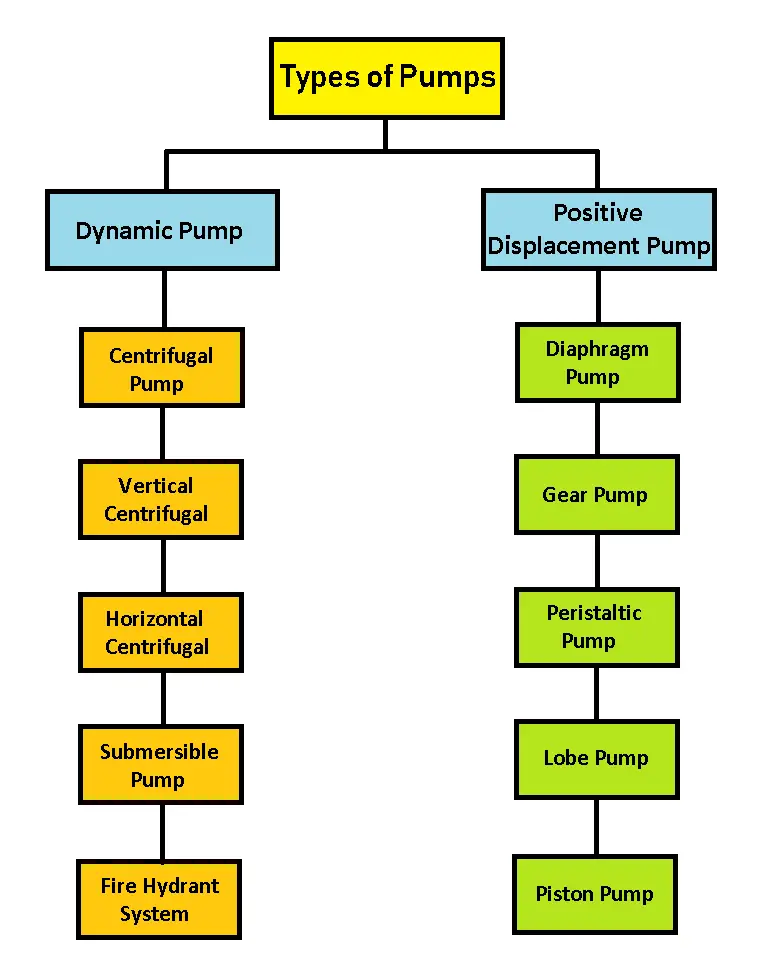
#1 Dynamic Pump
A dynamic pump uses centrifugal force to create velocity in the liquid. This velocity is further converted into pressure energy by decreasing the kinetic energy. This difference in pressure moves the fluid through the system.
It consists of a rotating impeller that creates a vacuum that moves the fluid. The impeller is held in the housing as it reduces the pressure at the inlet. This created motion drives the fluid outside the housing of the pump. At this stage, the pressure builds up to send it out for discharge. These are classified into two types.
#1 Centrifugal Pump
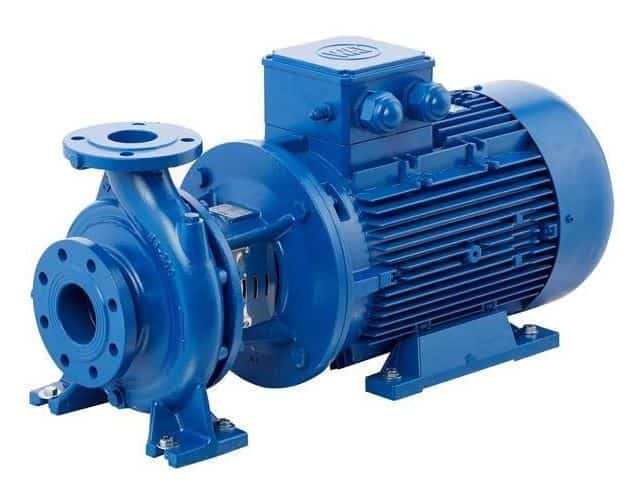
Centrifugal pumps are employed to move the fluid through the transfer of rotational energy from the rotor, this device is known as an impeller. The fluid enters the rotating impeller and is ejected by centrifugal force through the vane tip of the impeller.
This action of the impeller causes the fluid velocity and pressure to increase and also directs it toward the outlet. The pump casing is specially designed to compress fluid from the pump inlet, direct it into the impeller and control the fluid before discharging.
Pumps of this type are used for the water supply, fire protection systems, and beverage industries. These are also classified into three types, which are explained below.
#2 Vertical Centrifugal Pumps
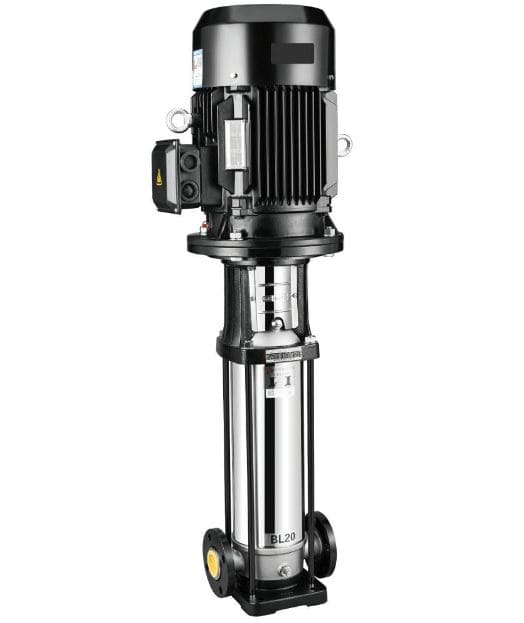
Vertical centrifugal pumps are also referred to as cantilever pumps. These pumps have a unique shaft and maintained design that allows the volume to fall inside the pit because the bearings are outside the pit.
These centrifugal pumps are frequently used to move water from wells or pits located deep underground. They have a motor, a discharge head, a line shaft, a pump shaft, a number of bowls, impellers, and a suction bell.
This pump uses a throttle bushing in its place of a filled container to cover the shaft. This kind of pump is frequently used with parts washers.
#3 Horizontal Centrifugal Pumps
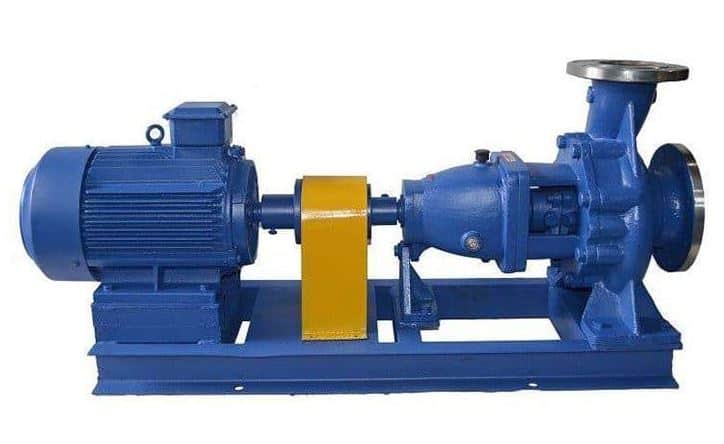
A horizontal centrifugal pump’s shaft will be horizontally positioned, usually overhung or in between the bearings. In contrast, the shaft of a vertical centrifugal pump is pointed vertically. These pumps have a minimum of two impellers, but sometimes more.
These pumps are used in the pumping industry. Fundamentally, every stage is a divide pump. Each phase is housed in the same shelter and mounted on the same shaft. A minimum of eight stages can be mounted on a single horizontal shaft; otherwise, additional stages can be mounted. Each stage improves the head by around the same amount.
These types of pumps are typically used in businesses that move sizable volumes of industrial fluids. This type of centrifugal pump has been made available as well as serviced by all types of pumps.
#4 Subermisble Pumps
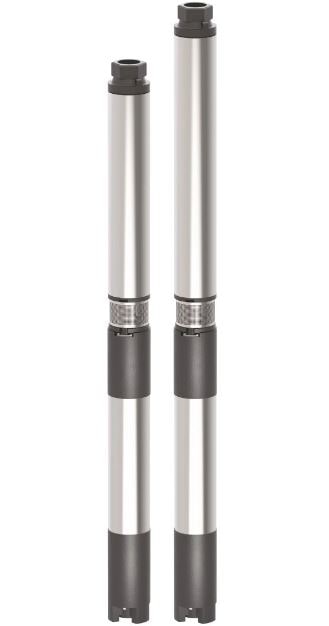
A submersible pump is a device with a tightly sealed motor that is close-coupled to the pump body. The entire assembly is submerged in the fluid being pumped. Submersible pumps are also known as stormwater, sewage, and septic pumps.
These types of pumps are primarily used in building services, domestic, industrial, commercial, rural, municipal, and rainwater recycling applications. These pumps are suitable for moving stormwater, subsoil water, sewage, black water, grey water, rainwater, trade waste, chemicals, bore water, and foodstuffs.
Different impellers are used in plumbing applications, including closed-type pumps, convection pumps, vortex pumps, multistage pumps, single-channel pumps, cutting pumps, and grinder pumps. A variety of options are available for various applications, including high flow, low flow, low head, and high head.
#5 Fire Hydrant System
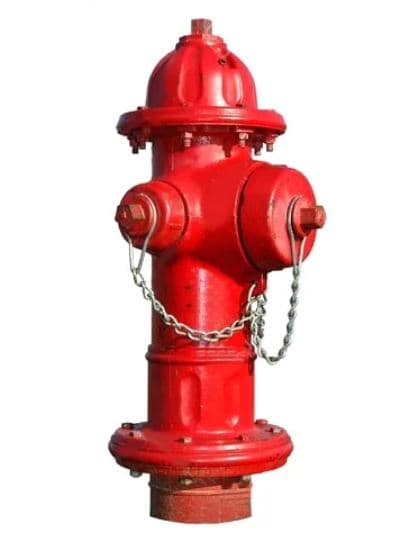
It is intended to offer quick access to water in the event of a fire. The purpose of a fire hydrant installation is to provide water for the firemen to fight a fire. Each hydrant outlet is supplied with water through a system of pipework that is directly connected to the water supply main.
Fire hydrant pump systems are also known as hydrant boosters, fire pumps, and fire water pumps. These powerful water pumps are designed to increase the hydrant service’s force because the mains are insufficient for construction site firefighting. The main uses for this system are for water transfer and irrigation.
You might like: What is Impulse Turbine and Pelton Wheel?
#2 Positive Displacement Pump
A positive displacement pump uses reciprocating, rotary, or pneumatic motion to move the liquid through the pump. Here, the discharge of the fluid occurs in the form of pulses instead of a smooth liquid flow.
These types of pumps are operated by trapping a fixed amount of fluid into the pump chamber at an inlet valve and then it discharges through an outlet valve. These pumps are utilized based on their ability to work in high-viscosity fluid at high pressure.
#1 Diaphragm Pump
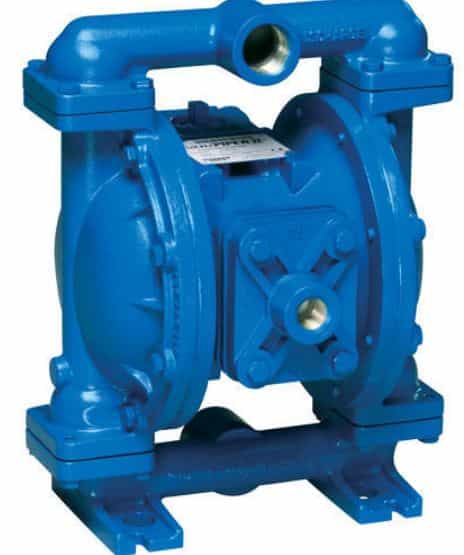
A diaphragm pump is a pump that uses a combination of reciprocating rubber, thermoplastic, or Teflon diaphragms. The diaphragm pump uses a rubber membrane and works on the air displacement principle.
In this type, the diaphragm is filled with one side of the fluid to be pumped (air or hydraulic fluid). As the volume of the chamber increases (the diaphragm moves upward), the pressure decreases, and fluid enters the chamber.
And when the pressure of the chamber is increased by the subsequently reduced volume (going down the diaphragm), the drawn fluid is drained out. Finally, the diaphragm moves again up, drawing fluid into the chamber, and completing the cycle.
#2 Gear Pump
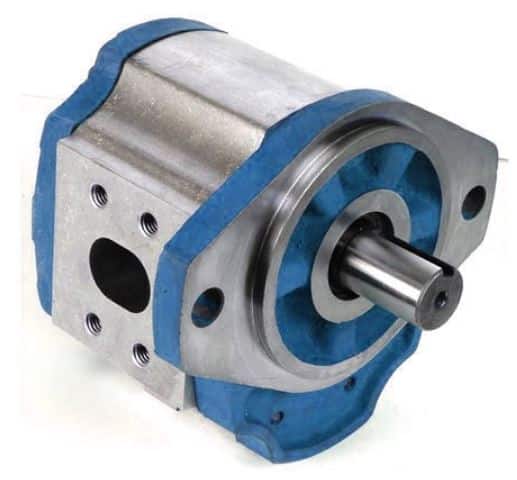
The gear pump uses gear meshing to pump the fluid by displacement. They are known as the most common types of pumps that are utilized for hydraulic power applications. As these gears rotate, they separate on the intake side of the pump which creates a vacuum and suction area for the fluid.
The fluid is moved by gears to the discharge side of the pump, where a meshing of gears replaces the fluid. This tighter clearance along with the speed of rotation of the gears effectively prevents fluid from leaking backward. The primary use of gear pumps is for pumping high-viscosity fluids in chemical installations.
#3 Peristaltic Pumps
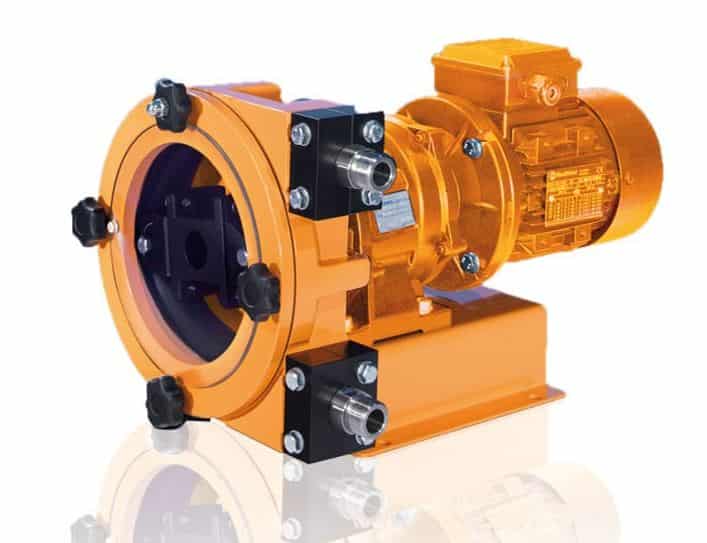
A peristaltic pump, also known as a roller pump, is a type of positive displacement pump that is used to pump a wide range of fluids. Inside of a spherical pump casing, the fluid is housed in a flexible tube. Although linear peristaltic pumps have also been created, the majority of peristaltic pumps operate through rotary motion.
These pumps fall under the category of positive displacement pumps, and their primary uses are in the processing of chemicals, food, and water. It can pump a variety of liquids, including toothpaste and various chemicals, and creates a steady flow for measuring and blending.
#4 Lobe Pumps
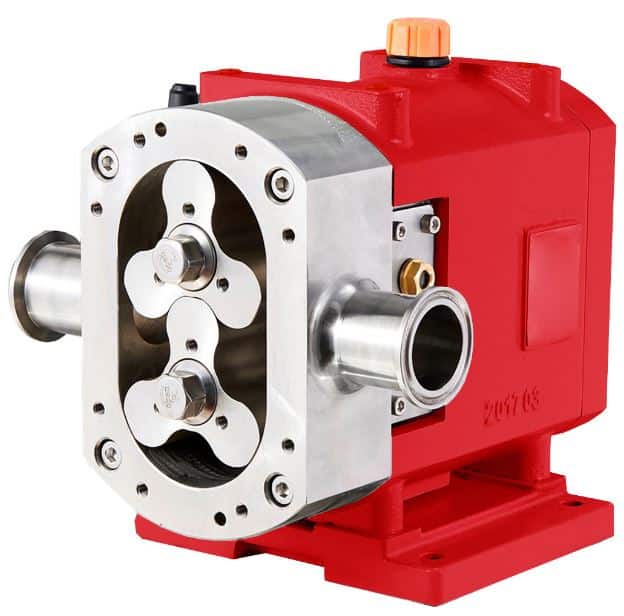
A lobe pump, also known as a rotary lobe pump, is a positive displacement pump. It is comparable to a gear pump, with the exception that the lobes are shaped to almost meet rather than touch and rotate one another.
Lobe pumps also have better pumping spaces than gear pumps, which enables them to move slurries. These are made of stainless steel and have a high degree of polish.
These pumps have a variety of qualities to offer, including excellent high efficiency, rust resistance, hygienic qualities, dependability, etc. These types of pumps are capable of handling solids and fluids with high thicknesses without damaging them.
#5 Piston Pump
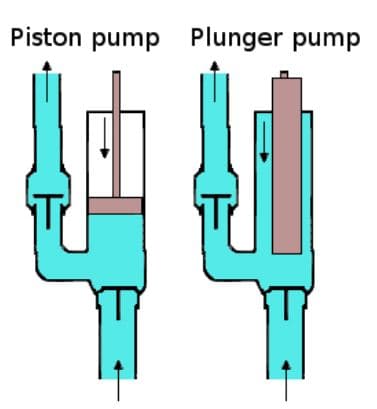
It is a positive displacement pump in which the high-pressure seal reciprocates with the piston. Piston pumps can be employed to compress gases or move liquids. They can function under a variety of pressures.
Piston pumps can also handle viscous and solid-particle media. It works through a piston cup, an oscillation mechanism, where downstrokes create pressure differentials, filling the pump chamber, then upstrokes push the fluid out.
Pumps like these are frequently used in water irrigation, paint transfer, chocolate, pastry, and other scenarios that require high, reliable pressure.
Closing It Up
As we already said, there are different types of pumps available in the market. I hope this article has helped you to know the main functionalities of each type of pump. The type of pump and selection mainly depends on our requirements.
So now, I hope I’ve covered everything about “types of pumps“. If you still have any doubts or questions on this topic, you can contact us or ask in the comments. If you like this article then please share it with your friends.
Want free PDFs sitting at home? Then subscribe to our newsletter.
Download PDF of this article:
Read more articles like this:
- What are the different types of Flow Control Valves?
- What Are The Difference Between Hydraulics and Pneumatic?
- Types of Pneumatic Valves & Their Applications
External Links:
Frequently Asked Questions
A pump is a mechanical device that transfers electrical energy into hydraulic energy to move fluids (liquids, gases, or occasionally slurries) mechanically.
Air is expelled from the path of the moving pump component as it starts to move (impeller, vane, piston diaphragm, etc.). The movement of air creates a partial vacuum (low pressure), which can be filled with more air or, in the case of water pumps, with water.
Following are the different types of pumps:
1. Centrifugal Pumps.
2. Vertical Centrifugal Pumps.
3. Horizontal Centrifugal Pumps.
4. Submersible Pumps.
5. Fire Hydrant Systems.
6. Diaphragm Pumps.
7. Gear Pumps.
When choosing an industrial pump, keep the following eight factors in mind:
1. Fluid Properties
2. Pump Capacity (Flow Rates)
3. Specialized Performance Factors
4. Energy Efficiency
5. Reliability
6. Ease of Use
7. Environmental Considerations
8. Control Systems
One of the most frequent reasons for pump failure is overheating. It can be caused by a number of things, including improper installation, insufficient lubrication, or foreign objects obstructing the cooling fins.
Positive displacement pumps force fluid through suction into a cavity or displaces the fluid within the cavity. Centrifugal pumps have a rotating impeller that pulls fluid into the pump and propels it out of the outlet point at a high velocity.
hello this is well documented information can I kindly get a pdf format
The PDF file has been sent to your inbox.
Which of the following types of pumps are also named as stormwater, sewage, and septic pumps?
Ans 1. Gear Pumps
2. Submersible Pumps
3. Reciprocating Pumps
4. Centrifugal Pumps
I found that option 2 is correct for the above question … Can you please tell in which text book , I will find it. Pls tell sir 🙏🙏.. Actually above question given in TSPSC AEE exam. But they the answer as “centrifugal pump”.. So to challenge that question, I need text answer sir .. So please tell, form where you collected the data about pumps??.. Pls tell me sir
The answer to the question is “Submersible Pumps” (Option 2). You can find information about this in textbooks related to fluid mechanics, wastewater engineering, or pump technology.
You have done a remarkable job of enriching the knowledge of the engineering community. I admire your persistent efforts. This is very enlightening.
Thank you for your kind words! I appreciate your support.
Great post, you have pointed out some superb points, I also think this s a very wonderful website.
Thanks for your feedback.
I read this article fully concerning the resemblance of the newest and previous technologies, it’s an awesome article.
Thanks for your feedback.
Can you answer this?
Which of the following types of pumps are also named as stormwater, sewage, and septic pumps?
Options :
1. Reciprocating Pumps
2. Centrifugal Pumps
3. Submersible Pumps
4. Gear Pumps
The type of pump that is commonly used for stormwater, sewage, and septic applications is Submersible Pumps.
Hello. Thank you for always good blog
You’re welcome.
You have brought up a very superb points, thanks for the post.
You’re welcome.
Hello,, kindly send me the PDF on pumps plus one about measuring instruments
The PDF file has been sent to your inbox.
I learned alot, by reading about these types of pumps
Glad to hear that you found the information about pumps informative!
Thank you. Very clear and simple explanation.
You’re most welcome.
This is very informative. This will help me on my studies.
Thanks for your feedback.
How do i get the PDF on this notes
The PDF file has been sent to your inbox.
I have tried downloading most of the books but I am been told error please how do l download them, thanks.
I just sent you the PDF file to your inbox. Please checkout.
Wow so nicely explained ❤️
Thanks for reading.